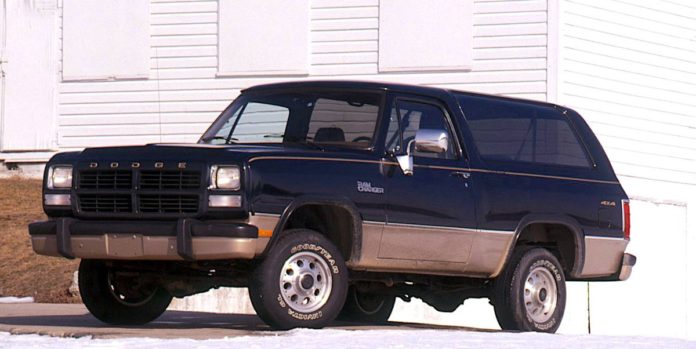From the July 1992 issue of Car and Driver.
Let’s agree from the outset that any car or truck is getting pretty grizzled after a production run of ten years or so. The Dodge Ramcharger full-size sport utility vehicle is now into its nineteenth model year.
Sleekness, sophistication, and charm are, none of them, merits of the Ramcharger. This is a big, brutish truck: 4823 pounds, six feet tall, nearly seven feet wide. It’s available with or without four-wheel drive, it offers a choice of V-8 engines, and, when properly configured, it can tow up to 7500 pounds. It wears its massive, defiantly unaerodynarnic sheetmetal like armor—”Let me loose in the parking lot,” it seems to say, “and I’ll squash the antifreeze out of that puny Suzuki Sidekick in the corner.”
Hoary it may be, but the ’92 Ramcharger is not without refinements. The news this year is a contemporary Canyon Sport appearance package and the addition of Dodge’s redesigned 5.2-liter V-8.
The Canyon Sport option discards the jumbo ram’s-head hood ornament and a lot of chrome in favor of a clean-looking two-tone paint job with a body-colored front grille.
Of greater import is the revised engine. Enhanced with sequential port fuel injection and treated to a thorough going-over (including redesigned cylinder heads and new intake and exhaust manifolds), the 5.2-liter V-8 now produces 230 horsepower at 4800 rpm and 280 pound-feet of torque at 3000—a substantial improvement over the old engine’s 170 horsepower and 260 pound-feet. Indeed, the new 5.2 produces 40 more horses than the Ramcharger’s optional 5.9-liter V-8— though the latter engine is torquier, grunting out 292 pound-feet at just 2400 rpm.
Mated to a four-speed automatic transmission (a five-speed manual is available), the new V-8 moves the Ramcharger from 0 to 60 mph in 10.2 seconds—a reasonable accomplishment considering the vehicle’s mass. No points for engine-note quality, however.
In the Ramcharger’s case, “fuel economy” sounds like an oxymoron: on the EPA city cycle, the V-8 sucks up a gallon of unleaded every 12 miles. A 34-gallon fuel tank helps minimize gas station visits.
The cabin is plain but commodious. Big, simple gauges. No-frills seats. Not an organic curve or designer switch in sight. Those who need their space will applaud the cargo room (86 cubic feet with the rear seat folded down). But hedonists will need to look elsewhere: The sparse optional luxuries include an AM/FM/cassette stereo and power windows, locks, and mirrors.
Rear-wheel ABS is standard on all Ramchargers. Our Canyon Sport test vehicle with the 5.2-liter V-8, an automatic, four-wheel drive, air conditioning, and power options totaled $23,783.
As more modern rivals, such as the new full-size Chevy Blazer, edge toward car-like response and feel, the Ramcharger remains steadfastly truck-like. Engine roar, heavy doors, numb steering, shudders from the body, a harsh broken-pavement ride—all conspire to expose the Ramcharger’s age.
Yet the Ramcharger soldiers on, with its square-jawed shape, rugged construction, and prodigious towing ability still winning hairy-armed fans. It’s a macho machine with a uniquely American cut and swagger. And it’s built in Lago Alberto, Mexico.
Specifications
Specifications
1992 Dodge Ramcharger Canyon Sport
Vehicle Type: front-engine, rear/4-wheel-drive, 5-passenger, 3-door wagon
PRICE
Base/As Tested: $20,190/$23,783
ENGINE
V-8, iron block and heads, Chrysler engine-control system with port fuel injection
Displacement: 318 in3, 5210 cm3
Power: 230 hp @ 4800 rpm
TRANSMISSION
4-speed automatic with lockup torque converter
DIMENSIONS
Wheelbase: 106.0 in
Length: 188.8 in
Curb Weight: 4823 lb
C/D TEST RESULTS
60 mph: 10.2 sec
1/4-Mile: 17.7 sec @ 77 mph
100 mph: 47.6 sec
Rolling Start, 5–60 mph: 10.6 sec
Top Speed (C/D est): 107 mph
Braking, 70–0 mph: 214 ft
Roadholding, 300-ft Skidpad: 0.73 g
C/D FUEL ECONOMY
Observed: 12 mpg
EPA FUEL ECONOMY
City: 12 mpg
C/D TESTING EXPLAINED

